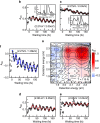Tracking the coherent generation of polaron pairs in conjugated polymers
- PMID: 27929115
- PMCID: PMC5155154
- DOI: 10.1038/ncomms13742
Tracking the coherent generation of polaron pairs in conjugated polymers
Abstract
The optical excitation of organic semiconductors not only generates charge-neutral electron-hole pairs (excitons), but also charge-separated polaron pairs with high yield. The microscopic mechanisms underlying this charge separation have been debated for many years. Here we use ultrafast two-dimensional electronic spectroscopy to study the dynamics of polaron pair formation in a prototypical polymer thin film on a sub-20-fs time scale. We observe multi-period peak oscillations persisting for up to about 1 ps as distinct signatures of vibronic quantum coherence at room temperature. The measured two-dimensional spectra show pronounced peak splittings revealing that the elementary optical excitations of this polymer are hybridized exciton-polaron-pairs, strongly coupled to a dominant underdamped vibrational mode. Coherent vibronic coupling induces ultrafast polaron pair formation, accelerates the charge separation dynamics and makes it insensitive to disorder. These findings open up new perspectives for tailoring light-to-current conversion in organic materials.
Figures

 to
to . The corresponding peaks are marked with dark blue circles. These splittings are the characteristic signature of strong vibronic coupling resulting in the formation of hybrid exciton-polaron-pair (XP) modes. The cross peaks with negative amplitude at detection energy of 1.89 eV originate from photoinduced absorption of polaron pairs. At longer waiting times (f) the splitting along the detection energy washes out and the resulting cross sections match those of the low-energy vibronic peaks in ΔT/T spectra. At all waiting times, negative amplitudes are observed for detection energy around 1.89 eV, monitoring polaron pair peak dynamics.
. The corresponding peaks are marked with dark blue circles. These splittings are the characteristic signature of strong vibronic coupling resulting in the formation of hybrid exciton-polaron-pair (XP) modes. The cross peaks with negative amplitude at detection energy of 1.89 eV originate from photoinduced absorption of polaron pairs. At longer waiting times (f) the splitting along the detection energy washes out and the resulting cross sections match those of the low-energy vibronic peaks in ΔT/T spectra. At all waiting times, negative amplitudes are observed for detection energy around 1.89 eV, monitoring polaron pair peak dynamics.

 and polaron pair
and polaron pair  and the dominant vibrational mode results in hybridized
and the dominant vibrational mode results in hybridized  states. (b,c) Simulated absorptive 2D maps in the absence of inhomogeneous broadening at waiting times of 6 and 120 fs, respectively. Positive peaks reflect bleaching of the
states. (b,c) Simulated absorptive 2D maps in the absence of inhomogeneous broadening at waiting times of 6 and 120 fs, respectively. Positive peaks reflect bleaching of the  transitions. The negative peak around 1.89 eV is due to excited state absorption from the
transitions. The negative peak around 1.89 eV is due to excited state absorption from the  manifold to the
manifold to the  state. Cross sections reveal distinct spectral splitting of the bleaching peaks, in good agreement with the experimental observations (Fig. 2a,b). (d) Dynamics of the positive diagonal peak amplitude at 2.06 eV. (e) Dynamics of the polaron pair peak for excitation at 2.26 eV and detection at 1.87 eV. A significant part of the polaron pair population is already formed during the first vibrational period. Fourier transforms (d,e insets) reveal the vibrational mode at 1,450 cm−1 and a weaker component around 500 cm−1 arising from electronic coupling between
state. Cross sections reveal distinct spectral splitting of the bleaching peaks, in good agreement with the experimental observations (Fig. 2a,b). (d) Dynamics of the positive diagonal peak amplitude at 2.06 eV. (e) Dynamics of the polaron pair peak for excitation at 2.26 eV and detection at 1.87 eV. A significant part of the polaron pair population is already formed during the first vibrational period. Fourier transforms (d,e insets) reveal the vibrational mode at 1,450 cm−1 and a weaker component around 500 cm−1 arising from electronic coupling between  and
and  . (f) Simulated linear absorption spectrum in the absence (green) and presence (red) of inhomogeneous broadening. For comparison, the black curve depicts the actual experimental data.
. (f) Simulated linear absorption spectrum in the absence (green) and presence (red) of inhomogeneous broadening. For comparison, the black curve depicts the actual experimental data.References
-
- Yu G., Gao J., Hummelen J. C., Wudl F. & Heeger A. J. Polymer photovoltaic cells: enhanced efficiencies via a network of internal donor-acceptor heterojunctions. Science 270, 1789–1791 (1995).
-
- Li G., Zhu R. & Yang Y. Polymer solar cells. Nat. Photon. 6, 153–161 (2012).
-
- Koezuka H., Tsumura A. & Ando T. Field-effect transistor with polythiophene thin film. Synthetic Met. 18, 699–704 (1987).
-
- Horowitz G. Organic field-effect transistors. Adv. Mater. 10, 365–377 (1998).
-
- Sekitani T., Zschieschang U., Klauk H. & Someya T. Flexible organic transistors and circuits with extreme bending stability. Nat. Mater. 9, 1015–1022 (2010). - PubMed
Publication types
Grants and funding
LinkOut - more resources
Full Text Sources
Other Literature Sources

